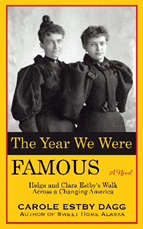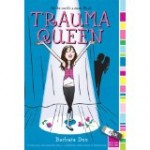
Barbara Dee
Yesterday, I posted a book review with giveaway information about Trauma Queen, author Barbara Dee’s latest book. Today, I’m featuring an interview with Barbara. who has also written This Is Me From Now On, Solving Zoe, and Just Another Day in My Insanely Real Life. As I mentioned in my review, I believe Trauma Queen is a great book for mother-daughter book clubs to read and discuss. It’s funny, and it brings up serious issues about the mother-daughter relationship that should provoke good discussions.
How did you decide you wanted to be a writer?
BD: Actually, I’ve always wanted to be a writer! In fact, I wrote my first book when I was five years old. It was called “Mitchell Colleps,” and it was about a naughty boy who had a robot who ate Spanish rice. What strikes me now (other than the Spanish rice-eating-robot!) is how much dialogue I wrote. It’s still my favorite thing to write!
If you’re curious, you can see a photo of “Mitchell Colleps” on my website, http://www.barbaradeebooks.com/about.html. I’ve also shared it on http://www.VYou.com/barbaradee.
Your books are often humorous. Do you think you have a sense of humor all the time or mostly when you are writing?
BD: Humor is very important to me, so I try not to save it all for my writing! Actually, my whole family is really funny. The point of dinner conversation at our house is to crack each other up. In fact, the “Funny Word List” in Just Another Day in My Insanely Real Life started out as something we came up with one evening over hamburgers! We’re also all obsessed with Monty Python, which we quote all the time.
Trauma Queen is a fun play on words for drama queen, which is a term often associated with teenage girls. Why did you decide to turn the tables in this book and have the mom be flamboyant and the daughter be responsible?
BD: As a mom myself, I hate to admit this, but I know that many girls, when they turn twelve or thirteen, start to look at their moms a bit critically. Even when they love their moms deeply, they’ll cringe at things their moms do or say. This sort of embarrassment is such a common tween emotion that I thought it would be fun to write about a truly off-the-charts embarrassing mom—a performance artist who has very few inhibitions, and who actually believes that “there is no such thing as negative publicity.” I wanted to show how brave and creative this mom is, as she tries to balance her work with her family obligations—but also how challenging from the daughter’s point of view.
One of the things Trauma Queen is about is how these two—the flamboyant, artistic mom and the responsible, sensitive daughter—figure out how to communicate with each other. I think they do it in a unique way that works for both of them, and in the end, I have high hopes for their relationship.
When you were a teen did you tend to be more like Marigold or her mom?
BD: Oh, I was definitely more like Marigold (but my own mom was nothing like Becca)! I was also very much like Evie in This Is Me From Now On—a good girl who is both fascinated and horrified by someone with a freer spirit.
Random acts of culture and organized performance events for flash mobs have been getting more popular lately. Do you see this as different than the performance art that Marigold’s mom creates, and if so how?
BD: Well, I’m not an expert on flash mobs, but from what I understand about them, they’re often pretty abstract. Becca’s performances usually make some sort of point (for example, she once wrapped herself in Saran Wrap to make fun of plastic surgery). She’s also such an individual that I can’t imagine her organizing 5000 people by Twitter for a pillow fight, or being part of a crowd that suddenly freezes in Grand Central Station.
Are you or have you been active in theater?
BD: When I was a kid, I was often cast as The Narrator in school plays. (Who knows why—maybe because I loved to read?) With such a dull role to play, being onstage wasn’t much fun for me. In college I reviewed plays for my school newspaper, which I really enjoyed. But that’s basically the sum total of my theatrical experience. I do love going to the theater, though, and I’m so happy that my three kids do, too.
Do you have a good theater warm-up exercise to recommend for mother-daughter book club members?
BD: Here’s one. Pair each mom with a daughter (not her own). Tell them to have a 30-second conversation consisting of YES and NO. (Assign YES to one, NO to the other. You might want to have them switch words at the 15-second mark.) The pair can use only these two words during the conversation, and they must maintain eye contact for the entire 30 seconds. It’s amazing how much you can say with these two words—if you don’t start laughing!
To see a video interview with Barbara Dee, see the Simon and Schuster website: http://books.simonandschuster.com/Trauma-Queen/Barbara-Dee/9781442409231









